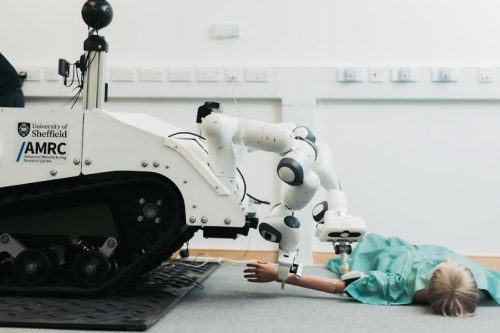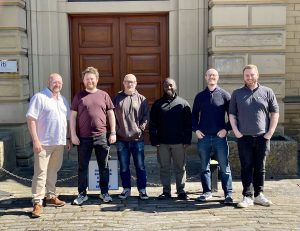Yorkshire researchers collaborate to develop ‘robo doctor’ technology

New robotic technology which can remotely treat casualties of a terrorist attack or major incident has taken a step closer to entering full production after it impressed at a special Ministry of Defence (MoD) event.
Researchers from the University of Sheffield Advanced Manufacturing Research Centre (AMRC), Sheffield Robotics and Department of Automatic Control and Systems Engineering, successfully put its ‘MediTel’ uncrewed ground vehicle (UGV) through its paces at BattleLab, an initial testing ground for new technologies which can be deployed in hazardous locations.
Design engineers took nine months to come up with a fully working prototype, leveraging the power of tech firm PTC’s Creo 3D Computer Aided Design (CAD) solution to take a standard UGV platform and two robotic arms to create, what many are calling, the next generation “Robo Doctor”.
One of three novel telexistence technologies funded through a two-phase £2.3m innovation competition run by the Defence Security Accelerator (DASA), it can be remotely operated from over one mile away by using Virtual Reality (VR).

David King
Testing has seen it successfully perform a critical initial assessment of a dummy casualty, including taking temperature, blood pressure, heart rate checks and even administering pain relief through an auto-injector.
It is hoped additional funding can be found to take the prototype forward with the longer-term possibility of scaling up for manufacturing in the UK.
David King, head of digital design at the AMRC, said: “Experts from the MoD were amazed that we have come up with a working prototype in just nine months and within the financial budget that was set.
“That is in no small part because of the long-standing relationship we have with digital transformation specialist PTC and its industry-leading design software.
“We went straight from sketches on paper to quickly designing the first model on Creo, using all its simulation and custom features to get there within a matter of weeks.
“This included how we mounted the robot on the platform, the mechanical engineering and how we integrated the power systems and arms.”
The MediTel robot can traverse rough terrain and can be used by operators located in a nearby vehicle or in a central hub.
A VR simulator places the user in the heart of the affected area, with a 360-degree camera giving a bird’s eye view of the patient and the situation.
Engineers at the AMRC believe any medical person can be trained on how to use the technology within 15 minutes.
Elliot Clarke, UKi regional director at PTC, added: “Our software is often at the heart of new innovations, and we are really pleased that it has now helped to create a piece of technology that could save thousands of lives all over the world.
“Creo is the ideal platform if you are looking for agile design, with the real time iterations allowing different team members to input the changes.
“The AMRC team has used Creo on hundreds of different projects and their knowledge of its capabilities and functions were imperative in meeting the nine-month project timeframe.”








